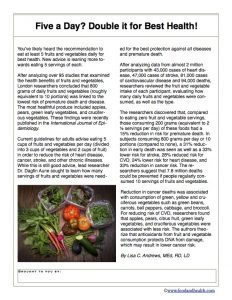Five a Day? Double it for Best Health!
You’ve likely heard the recommendation to eat at least 5 fruits and vegetables daily for best health. New advice is leaning more towards eating 5 servings of each.After analyzing over 95 studies that examined the health benefits of fruits and vegetables, London researchers concluded that 800 grams of daily fruits and vegetables (roughly equivalent to 10 portions) was linked to the lowest risk of premature death and disease. The most healthful produce included apples, pears, green leafy vegetables, and cruciferous vegetables. These findings were recently published in the International Journal of Epidemiology.Current guidelines for adults advise eating 5 cups of fruits and vegetables per day (divided into 3 cups of vegetables and 2 cups of fruit) in order to reduce the risk of heart disease, cancer, stroke, and other chronic illnesses. While this is still good advice, lead researcher Dr. Dagfin Aune sought to learn how many servings of fruits and vegetables were needed for the best protection against all diseases and premature death.After analyzing data from almost 2 million participants with 43,000 cases of heart disease, 47,000 cases of stroke, 81,000 cases of cardiovascular disease and 94,000 deaths, researchers reviewed the fruit and vegetable intake of each participant, evaluating how many daily fruits and vegetables were consumed, as well as the type.The researchers discovered that, compared to eating zero fruit and vegetable servings, those consuming 200 grams (equivalent to 2 ½ servings per day) of these foods had a 15% reduction in risk for premature death. In subjects consuming 800 grams per day or 10 portions (compared to none), a 31% reduction in early death was seen as well as a 33% lower risk for stroke, 28% reduced risk for CVD, 24% lower risk for heart disease, and 33% reduction in cancer risk. The researchers suggest that 7.8 million deaths could be prevented if people regularly consumed 10 servings of fruits and vegetables.Reduction in cancer deaths was associated with consumption of green, yellow and cruciferous vegetables such as green beans, carrots, bell peppers, cabbage, and broccoli. For reducing risk of CVD, researchers found that apples, pears, citrus fruit, green leafy vegetables, and cruciferous vegetables were associated with less risk. The authors theorize that antioxidants from fruit and vegetable consumption protects DNA from damage, which may result in lower cancer risk.By Lisa C. Andrews, MEd, RD, LDLike what you see? Share the handout!


